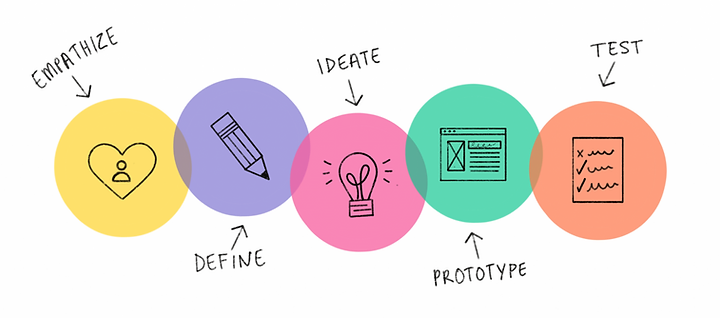By Vincent Loiseau.
Design Thinking is a way of thinking about innovation. Since its appearance more than 50 years ago, many companies have adopted this design method in their efforts to create new products or services.
With Design Thinking, the search for ideas involves more stakeholders by focusing the creative investigation on the human. It is a new approach to work organization dedicated to innovation and focused on the end user: we use the designer’s toolbox to find answers to any problem encountered by the consumer. The goal is to create a new product or service that often solves a social or economic problem.
There are 3 streams of the Design Thinking approach:
We will describe here the approach of the second one, which integrates a phase of empathy, necessary, from our point of view, to innovation.

The first step in the Design Thinking process is to gain an empathetic understanding of the problem you are trying to solve. This involves listening and talking with customers or users to learn more about the issue at hand:
The goal is to understand their experiences, their motivations, and to gain a deeper personal understanding of the issues at hand. Empathy is crucial to a human-centered design process such as Design Thinking. Empathy allows designers to set aside their own assumptions about the world in order to better understand users and their needs.
In this step, you gather the information you created and collected in the first step. This is where you analyze your observations and synthesize them to define the core problems you and your team have identified so far. You should seek to define the problem as a problem statement in a human-centered way.
For example, instead of defining the problem as your own wish or a business need, such as “We need to increase the market share of our food product with young teenage girls by 5%,” it would be better to define the problem as follows: “Teenage girls need to eat nutritious food to thrive, be healthy and grow.”
You learned to understand your users and their needs in the “Empathize” step, and you analyzed and synthesized your observations in the “Define” step, resulting in a human-centered problem statement. With this solid background, you and your team members can begin to “think outside the box” to identify new solutions to the problem statement you have created, and you can begin to look for other ways to view the problem. There are hundreds of ideation techniques :
You can now produce a number of small, inexpensive versions of the product or some of its features, in order to investigate solutions to the problems identified in the previous step. The prototypes can be shared and tested within the team itself, in other departments or on a small group of people outside the team. This is an experimental phase, the objective of which is to identify the best possible solution for each of the problems identified in the first three stages.
The solutions are implemented in the prototypes and, one by one, they are studied and either accepted, improved and reconsidered, or rejected based on the users’ experiences.
At the end of this stage, you will have a better idea of the inherent constraints of the product and the existing problems, and will have a clearer vision of how real users would behave, think and feel when interacting with the final product.
The complete product is rigorously tested using the best solutions identified during the prototyping phase. This is the final stage of a Design Thinking approach. However, it remains an iterative process, where the results generated during this phase are often used to :
During this testing phase, the solutions proposed by the prototypes can be refined or even completely discarded. The goal is to achieve the deepest possible understanding of the product and its users.